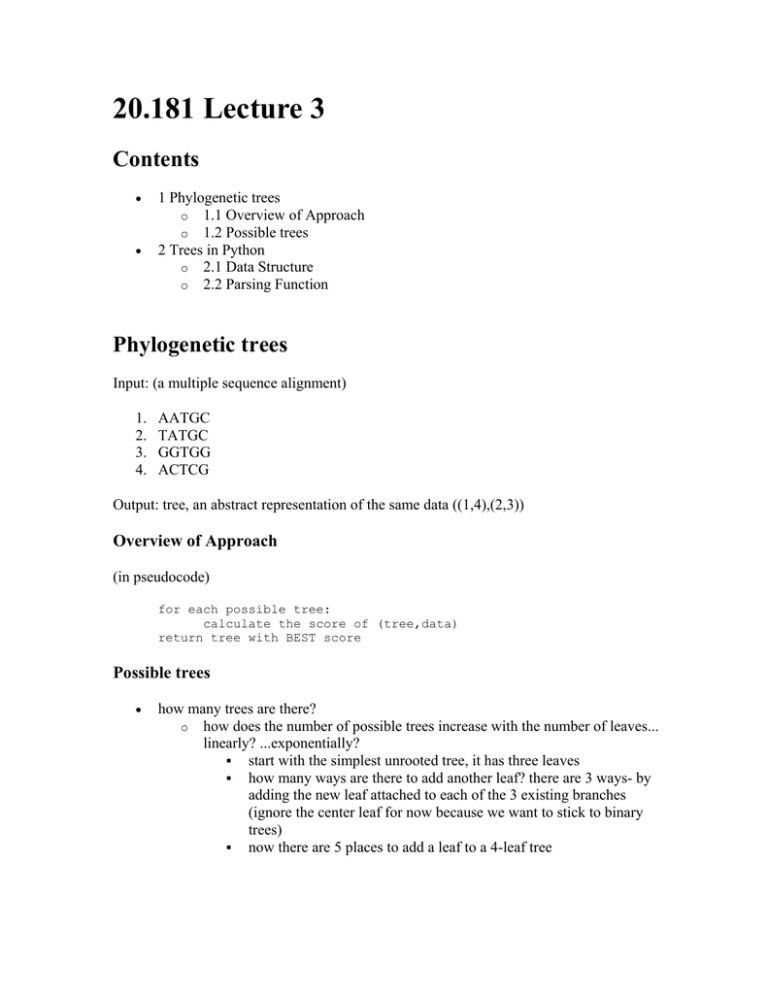20.181 Lecture 3 Contents
advertisement

20.181 Lecture 3
Contents
•
•
1 Phylogenetic trees
o 1.1 Overview of Approach
o 1.2 Possible trees
2 Trees in Python
o 2.1 Data Structure
o 2.2 Parsing Function
Phylogenetic trees
Input: (a multiple sequence alignment)
1.
2.
3.
4.
AATGC
TATGC
GGTGG
ACTCG
Output: tree, an abstract representation of the same data ((1,4),(2,3))
Overview of Approach
(in pseudocode)
for each possible tree:
calculate the score of (tree,data)
return tree with BEST score
Possible trees
•
how many trees are there?
o how does the number of possible trees increase with the number of leaves...
linearly? ...exponentially?
start with the simplest unrooted tree, it has three leaves
how many ways are there to add another leaf? there are 3 ways- by
adding the new leaf attached to each of the 3 existing branches
(ignore the center leaf for now because we want to stick to binary
trees)
now there are 5 places to add a leaf to a 4-leaf tree
o
o
o
o
every time you put a new branch down, you gain 2 more places to
put a new branch: one from splitting an existing branch into two
parts, and one from the new branch itself
f_trees(n) = f_trees(n-1) * (2n-5)
for n leaves, f_trees(n) = (2n-5)!! <- that double
factorial sign means to skip every other number
f_trees(n=10)= 34*10^6 f_trees(n=50) = 2.7*10^76
Enumerating trees is not possible, so we are going to look only at a small
number of possible trees. We need a search strategy. And the optimal
search strategy will depend on the nature of the problem you're looking at.
What about rooted trees... well, we can just pick one of the leaves to serve as a root. So
the number of rooted trees with n leaves is just the number of unrooted trees with (n+1)
leaves, and f_rooted(n) = (2n-3)!!
Trees in Python
•
For each node, we need to store:
1. names (and sequences?)
2. pointers to its left and right subtrees (its "children")
Data Structure
•
We're going to use a built-in dictionary as our data structure
o example tree = ((a,b),c)
tree1 = {'name':'a','left':None,'right':None} #for the
"subtree" that consists of leaf a
tree2 = {'name':'internal','left':tree1 ...
•
well, we could do that, referencing our dictionary defined above. OR we could
just avoid naming all the variables, and nest the definition of tree1 inside the
bigger tree (tree2 above)
tree2 =
{'name':'internal','left':{'name':'a','left':None,'right':N
one},'right':{'name':'b','left':None,'right':None}}
both approaches are equivalent.
Parsing Function
•
functions for dealing with this sort of data structure will be recursive
def leaves(tree):
if (tree['name'] != 'internal'):
return [tree['name']] # very important that this
returns a list
return leaves(tree['left']) + leaves(tree['right']) #
"+" concatenates lists
def tree2string(tree): #a function to print out your tree
in newick format
print '(' + left + ',' + right + ')'
•
You'll be writing functions like these on the next homework. This code will
probably have to be modified slightly to work in the correct context. (Note: the
second function here is just an outline, filling in the details is homework problem
#2.)





